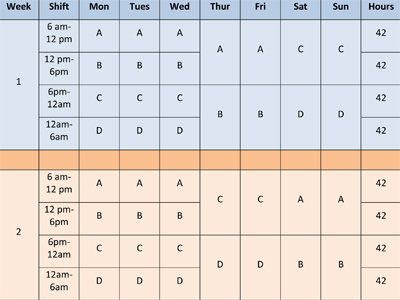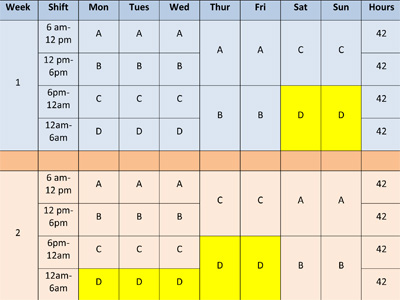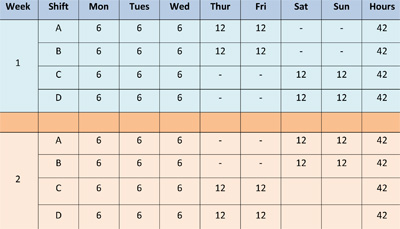A 4-Shift, Around-the-Clock Schedule EVERYONE Will Love—REVISITED
- Published: November 14, 2017
When I first wrote this article more than five years ago (CLICK HERE), I had no idea that it would be so popular. In fact, I’d say it is the most popular and commented upon article I’ve ever written. Because of this, I thought I’d do a follow-up blog to clarify a few points made by readers.
The subject of the article, of course, is a work schedule for manufacturing operations which have continuous production equipment that operate most efficiently when run 24 hours a day, seven days a week. By “work schedule,” I mean a work schedule that minimizes overtime cost to the manufacturer and reduces stress on manufacturing, supervisory and support employees, and improves overall safety, quality, and efficiency. Many schedules involve multiple 12-hour days separated by short breaks, for example, 11 days on, 3 days off, which become tiresome— even exhausting—on the employee. Exhaustion leads to an unsafe work environment, low job satisfaction, and other issues that are beyond the scope of this blog.
Traditional operations which could benefit from the schedule proposed below are larger firms with continuous operations, such as paper mills, plastics extrusion and molding facilities, metal foundries, refineries, etc., that cannot be easily shut down and that operate most efficiently when the machines are run continuously. By extension, some service operations may be able to benefit from the schedule below, provided appropriate staffing is available to cover all functions and fill four shifts.

The table to the right repeats the schedule previously published in September 2012. It shows a two-week rotation in which all four crews work 42 hours per week. I have assumed that the week starts on Monday so that employees can enjoy the weekends with the rest of the world. If labor laws in your state, province, or country vary, or if local labor contracts do not permit a Monday start to the week, then you would have to determine the number of hours worked weekly based on your individual work weeks. It is certainly possible to start this schedule on a Sunday to come into agreement with local and state work-week rules, but doing so would not provide the benefit of enjoying the weekend off with the rest of the world so to speak.
For ease of reading, the schedule in Table #1 starts on a Monday and is shown for two weeks to demonstrate its benefits by having a guaranteed weekend off every two weeks as well as having three “easy” days in between weekends. As mentioned above, there are several advantages to this schedule, such as job satisfaction, improved safety due to improved alertness, improved ability to cover vacation and sick days, and reduced overtime cost. None of these advantages are to be under-estimated. Staffing in operations with three-crews makes it difficult or impossible to cover for employees during vacation and holidays. Running short-staffed during these times is generally unsafe, leads to high turnover, and can put product quality and efficiency at risk.
With this schedule, four full crews are required to staff the machines. I labeled these crews as A, B, C, and D. The number of hours and days of the week that each shift works is shown above.

Each crew works only six hours Monday, Tuesday, and Wednesday. A- and B-shifts work Thursday and Friday, while C- and D-shifts work the first weekend of the two-week rotation. The following week, the 12-hour days are switched so that C- and D-shifts get the next weekend off while A- and B-shifts work.
If one follows this schedule closely, one will notice that each shift will have weeks in which they work seven consecutive days. While this is not perfectly desirable, these weeks contain three six-hour days in the middle which, in my experience, operators find delightful, and they are followed by two days off.
The next table (Table #2 above, right) shows the actual consecutive days a crew may work over the course of a two-week rotation. Following the “D” shift for example, one will notice that it indeed works seven consecutive days in each two-week cycle, Saturday through the following Friday.

Finally, Table #3 (right) shows a summary of hours worked by each crew per week under this arrangement.
While there may be no perfect 24/7 schedules out there, I think this one is close to it, as it guarantees two days off every week, and contains three “light” days every week.
It is during these light days that most people can conduct the chores of life so to speak, be it yard work, grocery shopping, visiting the registry of motor vehicles, cleaning out the basement, or other such pleasant tasks. I hope this clarifies any ambiguities that may have been contained in the previous blog on this topic.












